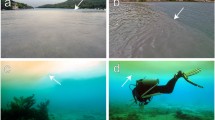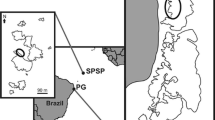Abstract
Bacterial numbers and frequency of dividing cells (FDC) were estimated in surface waters at seven stations along a transeet across One Tree lagoon and reefs at 2 h intervals over one tidal cycle in May 1984 and once a day on 8 d in December 1984/January 1985. Cell numbers ranged between 1.24 and 13.10x105 ml-1, with an overall mean value of 4.81x105. There was a progressive depletion in standing stock from windward to leeward stations across the lagoon, also reflected in the FDC, which generally showed similar dynamic patterns to cell numbers throughout the study. Predator-free seawater (filtered through 2 μm pore-size filters) and mucus-enriched incubations were also used to establish the relationship between the growth rate (μ) and FDC for coral-reef populations. Average growth rates predicted from FDC values ranged from 0.062 to 0.174 h-1, which is equivalent to doubling times of 5.74 to 16.00 h, with an overall mean value of 11.5 h. These fast doubling times suggest that bacteria respond rapidly to pulses of enrichment as they float over the lagoon and reefs, characteristically achieving about one doubling per tidal cycle. This probably ensures that the bulk of labile organic matter and dissolved nutrients is conserved within the immediate coral-reef environment. Estimates of bacterial production also suggest that they may contribute up to 40% of total picoplankton production and about 25% of total microplankton production. Pelagic bacteria are therefore potentially a major food resource for benthic filter-feeders, especially for those mainly dependent on the smaller (pico) components of the plankton.
Similar content being viewed by others
Literature cited
Atkinson, M.: Phosphorus in coral reef ecosystems. In: Proceedings of the Great Barrier Reef Conference, pp 271–275. Ed. by J. T. Baker, R. M. Carter, P. W. Sammarco and K. P. Stark. Townsville, Qd.: James Cook University Press 1983
Bratbak, G. and I. Dundas: Bacterial dry matter content and biomass estimations. Appl envirl Microbiol. 48, 755–757 (1984)
Burns, D., C. Andrews, D. Craven, K. Orett, B. Pierce and D. Karl: Microbial biomass, rates of DNA synthesis and estimated carbon production in Kaneohe Bay, Hawaii. Bull. mar. Sci. 34, 346–357 (1984)
Coles, S. L. and R. Strathmann: Observations on coral mucus ‘flocs’ and their potential trophic significance. Limnol. Oceanogr. 18, 673–678 (1973)
Crossland, C. J., D. J. Barnes and M. A. Borowitzka: Diurnal lipid and mucus production in the staghorn coral Acropora acuminato. Mar. Biol. 60, 81–90 (1980)
Ducklow, H. W.: The production and biomass of bacteria in coral reefs. In: Ecosystems of the world, Ed. by Z. Dubinsky. Heidelberg: Springer-Verlag (In press)
Ducklow, H. W. and S. M. Hill: Tritiated thymidine incorporation and the growth of heterotrophic bacteria in warm core rings. Limnol. Oceanogr. 30, 260–272 (1985)
Ducklow, H. W. and R. Mitchell: Composition of mucus released by coral reef coelenterates. Limnol. Oceanogr. 24, 706–714 (1979a)
Ducklow, H. W. and R. Mitchell: Bacterial populations and adaptations in the mucus layers on living corals. Limnol. Oceanogr. 24, 715–725 (1979b)
Entsch, B., K. G. Boto, R. G. Sim and J. T. Wellington: Phosphorus and nitrogen in coral reef sediments. Limnol. Oceanogr 28, 465–476 (1983)
Fallon, R. D., S. Y. Newell and C. S. Hopkinson: Bacterial production in marine sediments: will cell-specific measures agree with whole-system metabolism? Mar. Ecol. Prog. Ser. 11, 119–127 (1983)
Ferguson, R. L., E. N. Buckley and A. V. Palumbo: Response of marine bacterioplankton to differential filtration and confinement. Appl. envirl Microbiol. 47, 49–55 (1984)
Frith, C. A.: Circulation in a platform reef lagoon, One Tree Reef, southern Great Barrier Reef. Proc. 4th int. Symp. coral Reefs 1, 347–354 (1981) (Ed. by E. D. Gomez et al. Quezon City, Philippines: Marine Sciences Center, University of the Philippines)
Fuhrman, J. A.: Influence of method on apparent size distribution of bacterioplankton cells: epifluorescence microscopy compared to scanning electron microscopy. Mar. Ecol. Prog. Ser. 5, 103–106 (1981)
Gordon, D. C., R. O. Fournier and G. T. Krasnick: Note on planktonic primary production in Fanning Island lagoon. Pacif. Sci. 25, 228–233 (1971)
Gottfried, M. and M. R. Roman: Ingestion and incorporation of coral-mucus detritus by reef zooplankton. Mar. Biol. 72, 211–218 (1983)
Hagström, Å., U. Larsson, P. Hörstedt and S. Normark: Frequency of dividing cells, a new approach to the determination of bacterial growth rates in aquatic environments. Appl. envirl Microbiol. 37, 805–812 (1979)
Hanson, R. B., D. Shafer, T. Ryan, D. H. Pope and H. K. Lowery Bacterioplankton in Antarctic Ocean waters during late austral winter: abundance, frequency of dividing cells and estimates of production. Appl. envirl Microbiol. 45, 1622–1632 (1983)
Hatcher, B. G.: The role of detritus in the metabolism and secondary production of coral reef ecosystems. In: Proceedings of the Great Barrier Reef Conference, pp 317–324. Ed. by J. T. Baker, R. M. Carter, P. W. Sammarco and K. P. Stark. Townsville, Qd.: James Cook University Press 1983
Hatcher, A. I. and B. G. Hatcher: Seasonal and spatial variation in dissolved inorganic nitrogen in One Tree reefs and lagoon. Proc. 4th int. Symp. coral Reefs 1, 421–424 (1981). (Ed. by E. D. Gomez et al. Quezon City, Philippines: Marine Sciences Center, University of the Philippines)
Hobbie, J. E., R. J. Daley and S. Jasper: Use of Nuclepore filters for counting bacteria by epifluorescence microscopy. Appl. envirl Microbiol. 35, 1225–1228 (1977)
Johnstone, R. W., K. Koop and A. W. D. Larkum: Fluxes of free ammonium between sediments and water in a coral reef lagoon. Mar. Ecol. Prog. Ser. (In press)
Landry, M. R., L. W. Haas and V. L. Fagerness: Dynamics of microbial plankton communities: experiments in Kaneohe Bay, Hawaii. Mar. Ecol. Prog. Ser. 16, 127–133 (1984)
Larkum, A. W. D.: The primary productivity of plant communities on coral reefs. In: Perspectives on coral reefs, pp 221–230. Ed. by D. J. Barnes. Townsville, Qd.: Australian Institute of Marine Science 1983
Linley, E. A. S. and R. C. Newell: Bacterial growth yields on plant detritus. Bull mar. Sci. 35, 409–425 (1985)
Moriarty, D. J. W.: Biomass of suspended bacteria over coral reefs. Mar. Biol. 53, 193–200 (1979)
Moriarty, D. J. W., P. C. Pollard and W. G. Hunt: Temporal and spatial variation in bacterial production in the water column over a coral reef. Mar. Biol. 85, 285–292 (1985)
Newell, S. Y. and R. R. Christian: Frequency of dividing cells as an estimator of bacterial productivity. Appl. envirl Microbiol. 42, 23–31 (1981)
Platt, T., D. V. Subba Rao and B. Irwin: Photosynthesis of picoplankton in the oligotrophic ocean. Nature, Lond. 301, 702–704 (1983)
Richman, S., Y. Loya and L. B. Slobodkin: The rate of mucus production by corals and its assimilation by the coral reef copepod Acartia negligens. Limnol. Oceanogr. 20, 918–923 (1975)
Smith, S. V.: Net production of coral reef ecosystems. In: The ecology of deep and shallow coral reefs. NOAA Symp. Ser. Undersea Res. 1, 127–131 (1983)
Sorokin, Y. I.: Trophical role of bacteria in the ecosystem of the coral reef. Nature, Lond. 242, 415–416 (1973)
Sorokin, Y. I.: Aspects of the biomass, feeding and metabolism of common corals of the Great Barrier Reef, Australia. Proc. 4th int. Symp. coral Reefs 2, 27–32 (1981). (Ed. by E. D. Gomez et al. Quezon City, Philippines: Marine Sciences Center, University of the Philippines)
Spencer-Davies, P.: The role of zooxanthellae in the nutritional energy requirements of Pocillopora eydouxi. Coral Reefs 2, 181–186 (1984)
Turley, C. M. and K. Lochte: Direct measurement of bacterial productivity in stratified waters close to a front in the Irish Sea. Mar. Ecol. Prog. Ser. 32, 209–219 (1985)
Van Veen, J. and E. A. Paul. Conversion of biovolume measurements of soil organisms grown under various moisture tensions, to biomass and their nutrient content. Appl. envirl Microbiol. 37, 686–692 (1979)
Author information
Authors and Affiliations
Additional information
Communicated by J. Mauchline, Oban
Rights and permissions
About this article
Cite this article
Linley, E.A.S., Koop, K. Significance of pelagic bacteria as a trophic resource in a coral reef lagoon, One Tree Island, Great Barrier Reef. Mar. Biol. 92, 457–464 (1986). https://doi.org/10.1007/BF00392505
Accepted:
Issue Date:
DOI: https://doi.org/10.1007/BF00392505




